The most important part of your bike isn’t the suspension, the wheels or the frame, but rather you. Any bike can sit on a showroom floor valued at more than a brand new hatchback, but a bike is built to be ridden and that requires the valuable component of a human. But then what is the most important part for the rider then? Aside from fitness and a can-do-attitude to ride some trails, you need a quality mountain bike helmet. Runners can be used rather than 5 Ten clipless shoes, a daggy T-shirt is more than qualified to replace a Fox racing jersey, and while it does feel uncomfortable, cargo shorts can be worn rather than chamois shorts. But I digress from uncomfortable feelings of chafe, because a proper certified mountain bike helmet is what you truly need to get into mountain biking regardless of the price of the bike or how many gears it has.
This post is more or less the result of my helmet being cracked during the crash that also injured my shoulder. I have thought about helmets and their role in safety in the past, one of my first rider files was the types of injuries in the sport of mountain biking and how head trauma constitutes a large portion of severe crashes (https://throughanamateurseyes.wordpress.com/2016/02/06/rider-files-2-mountain-bike-warriors/). In my piece on introducing new people to the sport, my number one rule above all else was to ensure they had a quality mountain bike helmet that fit them before they even touch a dropper post remote (https://throughanamateurseyes.wordpress.com/2017/04/16/rider-files-16-recruiting-riders/). Helmets are pretty serious stuff and should be treated with as much respect as your drive-train or brakes. Without a helmet, the first time you come off a bike and smack your head into a rock, it would be a one way ticket to a mechanical ventilator and a front row seat in an intensive care unit. So how did we get to the point of full face downhill helmets, MIPS, and my partner having a bright pink trail helmet even though her top speed is 18km/hr?
What we know as helmets can be traced back to the “hairnets” used in road cycling. Consisting of leather strap/belt around the circumference of the head and then leather straps across the top of the head and a chin strap underneath, these had the goal of reducing abrasions and lacerations when hitting the ground rather than cushioning the head. These were the times where CT wasn’t invented yet and riders would notice superficial injuries such as cuts and open wounds rather than internal bleeding of the brain due to impact injuries.
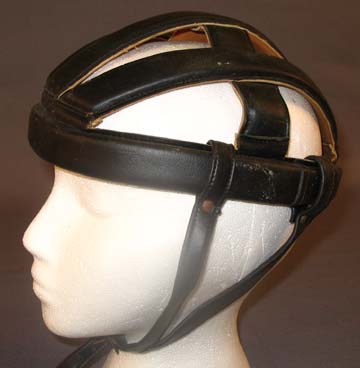
Around the 1970’s, companies that produced helmets for motor racing began to realise that cyclists were dying from severe head trauma. To address this, they began making and marketing motorcycle-like helmets to cyclists such as this Fury to sell their product but protect their customers.
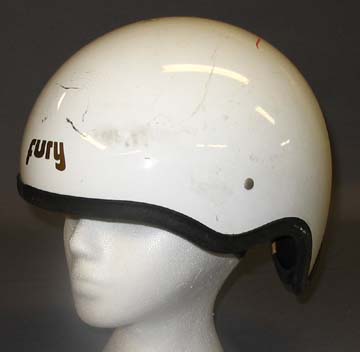
While it was a step in the right direction, the problem was there were no specific safety standards like there are now. The early bike helmets were often heavy, and while there were hard and durable, they didn’t cushion the head on impact but rather had a hardened skin. Bicycle riding groups at the time started collating data and testing different ideas until they realised that bicycle helmets would need to become separate to motorcycle and car helmets. A soft polymer or foam lining would be needed on the inside, a way to anchor that to the rider’s head, and then an outer protective case to protect the lining from the elements. This laid the foundations for what we know as a bicycle helmet.
Government safety regulations dictate whether a helmet has the ability to protect a rider in the event of a direct head impact. Helmets are only designed to take a single major impact (therefore save the person’s life) and be destroyed, but if a helmet is deemed unable to absorb the appropriate amount of force and reduce the blunt trauma to a person’s head, then it won’t pass safety standards. And while cheap manufacturers can make “helmets” out of the same foam you get from take away coffee cups, slap a sticker on it and sell it to you cheaper than two onions, unless the government recognises the specific helmet passing their testing then it is useless. For example, I knew a boy in my home town who had bought a helmet from a department store because it had Spiderman on it and the mother saw it had “the Australian tick of approval” sticker on the inside. Being a kid, one day he was riding in the streets and slipped and hit his head on the asphalt. The helmet smashed into literally hundreds of pieces and he was in a children’s hospital for months recovering. During his recovery, the mother found out the helmet hadn’t met Australian standards. Lesson is, just because it has a tick on it doesn’t mean it gets full marks. Do your homework!
So provided a helmet can absorb a large enough impact to significantly reduce cranial trauma; what exactly are mountain bike helmets, how do the designs vary and why is MIPS such an important thing all of a sudden? Why don’t cross country riders have full face helmets? Why do downhill riders also wear neck collars? Why do proper mountain biking helmets cost so much? And is there any future developments in the field of mountain biking helmets?
Anatomy and Divergence of the Mountain Bike Helmet
A mountain bike helmet has two main parts, the retainer and the shell. The shell is the styrofoam/polymer layer that protects your head in a crash by absorbing the impact and either deforming or breaking as a result. The retaining mechanism is made of the straps and loops that help to keep the shell on your head. MIPS more or less falls within the retaining system since it links between the shell and the retainer, but that is only if the helmet has this protection mechanism. Everything else including visors, ratchet system, pads and attachment points fit to the shell.
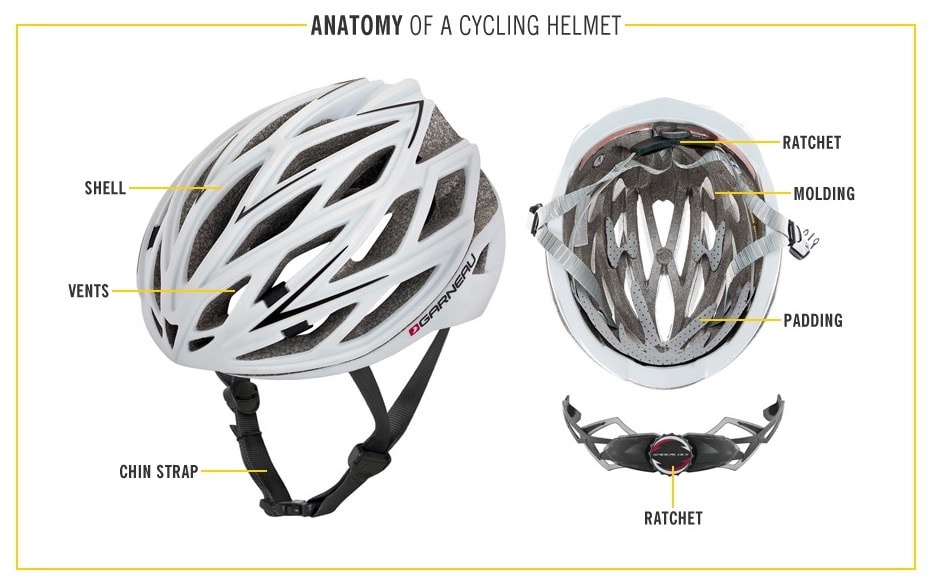
With the basic anatomy out of the way, comparing the above road bike helmet to the image below, what do you notice?
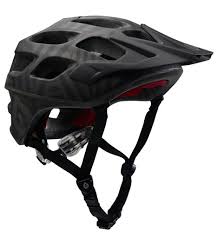
The most notable aspect about the shell is the lower rear portion of the helmet. Protecting the occiput (lower back part of the brain), this longer rear part of the helmet serves to protect the back of you head when falling backwards in the event you wheelie or flail out of control on a downhill crash. With road riders being in a more “controlled environment” where they either go over the handlebars or fall off sideways, road bike helmets favour ventilation and lightweight construction rather than greater protection and sturdy design. Considering that a road bike can get up past 60km/hr, a mountain bike helmet may strike rock, wood, metal or soil at a variety of speeds at odd angles. With a lower rear guard, there is also less ventilation compared to a road bike helmet since you don’t want branches or rocks spearing through the gaps and slicing the rider’s head open. Finally the visor is larger in order to shield the rider’s eyes from high sun. It isn’t overly aerodynamic, but with mountain bikers wanting to have “more fun” rather than break land speed records, a broad visor is good.
Divergent Evolution of the Mountain Bike Helmet
At some point mountain bike helmets would have had a common ancestor, maybe something like the smooth shell Fury helmet or something akin to a “basic” bicycle helmet you see in department stores. But why is it that cross country helmets resemble road bike helmets and downhill riders use full face helmets?
First and foremost, consider what I just stated. Cross country riders are often doing long distance races in which the rider needs to be comfortable for long periods but at the same time they need to be protected from impacts such as falling off frontwards, sideways and backwards. Enduro riders will often pedal uphill at a moderate pace, but want full protection for when they do their timed downhill runs. And downhill riders are going at insanely fast speeds downhill over incredibly rough terrain, with the ability to fall any direction and also be rotated in any direction in the air.
This means that cross country helmets are as light and ventilated as possible, but have a durable helmet shell to protect against high speed crashes. They need to be able to breathe easily, as such a chin guard is not required. When you watch a world cup cross country race, most of the time they fall sideways after washing out, or over the bars in a rock garden. While they do rarely go backwards in some miraculous crashes, they risk occiput protection in order to have a more lightweight and breathable helmet.
Enduro helmets are the evolution of trail helmets where they have the occiput protection at the rear, but then incorporate removable chin guards to allow their riders to smash the downhills. Without the chin guard on the climbs, enduro riders can breathe more efficiently on the climbs and drink water easily during the transition stages. But by attaching a small piece of equipment to the base of the helmet, the reinforced chin guard protects the rider’s mandible and facial bones during high speed crashes similar to a downhill rider.
Finally, the downhill helmet provides impact protection from almost every angle of the head and the chin guards is integrated into the base helmet. This allows for maximum structural integrity and a lighter weight design than an enduro helmet. Only having to sprint a section of downhill trail, they never slow for a drink and the excessive speeds allows for air to rush over their face and head to cool them. On top of this, they also have neck collars to protect from whiplash. While most people look to head injuries as the worst injury to a mountain biker, if someone’s neck bends or compresses with enough force in the wrong direction, a mountain biker could become para- or quadriplegic, or possibly severe their vertebral arteries and die. To prevent abnormal neck movements, a downhill helmet is supported by a neck brace to prevent these kinds of injuries. Downhill helmets are the most utilitarian of the mountain bike helmet family, but with the speeds these riders reach and how their body can end up in any rotational axis, it’s better to be safe than sorry.
MIPS and the Brain
So far I have talked about how helmets protect from direct impacts during a crash. Seems simple enough that if you smack your head against a surface dead straight, you injure your brain since it is surrounded by liquid (cerebrospinal fluid) and is floating in your skull cavity. Smashing your brain means it runs forward into the skull and collides into the skull and becomes bruised to a minor extent, or it compresses and destroys blood vessels causing a haemorrhage or “brain bleed” in a major incident. Since blood is not meant to be on the outside of the brain and intracranial bleeding causes an increase in cranial fluid pressure, soon the bleeding compresses the brain so much it destroys it and we die of brain death. But this is only if we consider direct impacts to the brain and how a regular old helmet might save you. Why is MIPS so important?

We have been considering impacts as a perpendicular force to the point of the skull. But in mountain biking, forces can strike us from different angles and the surfaces can be on different angles them self. If the back of my head hit a rock that was 45 degrees to the point of impact, then as my head hit, 50% of the force would be imparted straight up into my head, and the other 50% goes to the side which can cause rotation and translation forces within my head (in theory 50/50%). And when friction is accounted for and the fact your impact doesn’t stop the nanosecond your head hits a surface, hitting your head on any oblique surface means your head starts to rotate as you experience the impact and continues to do so. That means your brain starts to spin in any direction and that causes small impacts around the edge, the spin also means your neck can start to rotate and flex at odd angles, and finally your rotating head can be subjected to G-forces in any direction and magnitude which multiplies the damage. So after taking our simple model of head hits wall and adding in rotational forces, how can a MIPS helmet help?
First, you still have the outer shell which absorbs the initial impact. Styrofoam crumples on impact, and remaining forces are transmitted to the head still. But then the MIPS liner (multi-directional impact protection system) begins to rotate on itself to start cancelling out the oblique impact angles.
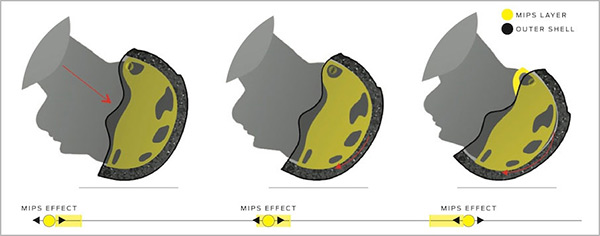
From the diagram, you can see that the outer shell begins to rotate while the inner MIPS liner and head remain straight. While this still seems to paint a grim picture for the rider crashing, it is better than if the outer shell gripped the ground during the crash and caused hyper-extension of the neck and the rotation of the brain within the cerebrospinal fluid. With the outer shell taking the majority of the force out of the impact and the MIPS then removing some of the rotational forces, brain and spinal related injuries are minimised. Which is great.
However, MIPS is a patented system and for that reason, companies producing helmets with the MIPS liner technology must pay royalties to the inventor. On top of this, the helmet company also needs to pay for the additional material costs that go into a MIPS liner. In the world of legalities, manufacturing and sales, it is either the consumer that must pay the excess in order to receive patented technology, or the company risks getting sued by cutting corners in legal processes in using patented technologies. In an ideal world, MIPS would be a patented but free to use product like the three point seat belt that was invented by Volvo and has now become the industry standard, but this is not the case in the world of bicycles and safety…
The Future of Helmets
There are two directions that bicycle helmets can take and one seems more practical while the other seems to be a bit unique. One is available right now and will become the evolution in MIPS, while the other may not pass safety requirements in certain countries. And so we have the WaveCell against the neck airbag.
The Bontrager WaveCell builds upon the design principles of the MIPS liner, where this liner can rotate under impact to protect the rider’s brain from rotational and directional forces. But the WaveCell has the ability to deform in all directions and in more complex ways than what the MIPS liner is currently capable of, allowing for a greater reduction in head and neck related injuries. It will be interesting to see if the WaveCell patent becomes free for market use, if Bontrager will sell the rites to other manufacturers to use in their helmets, or if it will remain a Bontrager design exclusively. But for now there is a revolution on top of the MIPS.
Then there is the neck airbag pillow from Sweden, which is set to revolutionise helmet design for those that don’t want to ride around with a helmet. Wait, what?
For some reason this device pops up in my Facebook news-feed thanks to Interesting Engineering and every cycling enthusiast page moderated by a Russian spam bot, and boy does it present some advantages and risks. From the left picture, you can see that the helmet deploys when it senses you going from riding position to “almost on the ground”, and on the right is demonstrates that it flawlessly integrates into your black dress, providing you are a sleek Swedish super model with a tall thin neck and can pull off black. Jibs aside, my first problem is the left picture. At what point does the neck airbag sense you are about to fall and thus deploy the airbag? If I sneezed hard enough and my head tilted forward at speed, does that mean it will deploy? And in the Facebook videos it shows it can inflate in a fraction of a second to ensure it’s there when you hit the deck, but what if you head is about to hit a tree like on the third freeze frame and thus it hasn’t inflated to protect you? And being a single use item is great for those of you that want it for a one time occasion but don’t want to ride with a helmet, but how do you ensure its integrity? You can take one look at a helmet and realise how damaged it is or if it’s integrity is compromised after being ridden for three years, but what if you crash one day and the airbag doesn’t deploy? And what if it gets caught in your clothes?
Moving to the right image, it demonstrates how sleek it looks as a “scarf” and how it deploys to become the Michellen Man’s downhill helmet. Great, but what if you have a short fat neck? What if your jumper covers the rear of the neck airbag and prevents it from fully deploying? When a regular airbag deploys it is often scorching hot thanks to the chemical reaction used to instantaneously inflate the bag and has a vent hole to ensure you don’t smash your face into an exercise ball. Does this helmet use the same inflation reaction and how cushion-y/rigid is the helmet part? And do you need to replace the entire assembly after a crash or does it come with refills?
Obviously this would never work for mountain biking, but even as a road biking or commuting helmet, I am definitely skeptical as to how this works and the effectiveness of the design. Great click-bait, poorly thought out idea…
Shell Out
Seeing as we only have one brain and it kind of helps to keep it intact, if you’re into the sport of mountain biking or any cycling discipline, it is vital that you buy a quality mountain bike helmet to save yourself. For the $150-300 you spend on a quality helmet, you are assured it will protect your head in a crash, and some stores will provide a free replacement in the event that you crash in reasonable circumstances within the first year. That is how dedicated some stores are to protecting your brain. While some people remain skeptical about MIPS and there are even a few that believe helmets cause greater brain injury than not wearing a helmet (but there are also flat earthers), if you invest in a quality helmet regardless of MIPS or WaveCell, it will out you in a better position to survive than buying a $20 department store helmet and ensuring your next ride ends in an intensive care unit stay. So ride in cargo shorts and sneakers, but please get a decent helmet to save your life?


